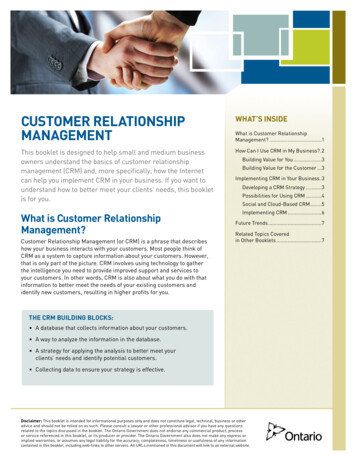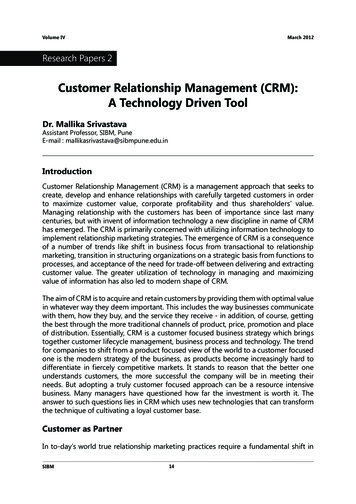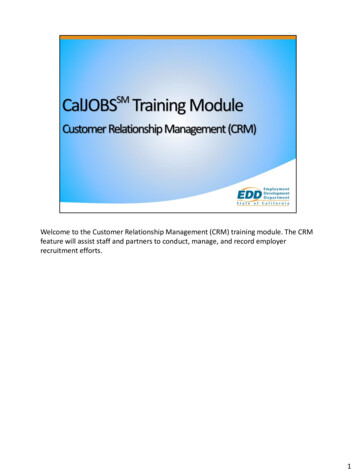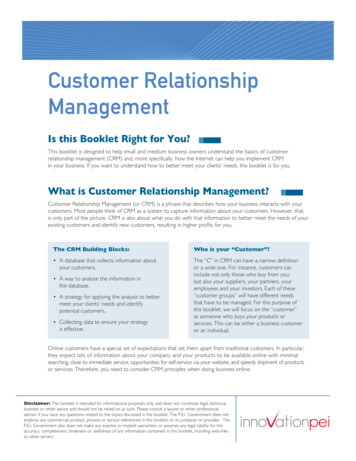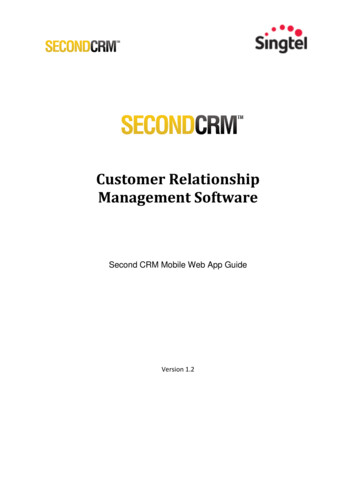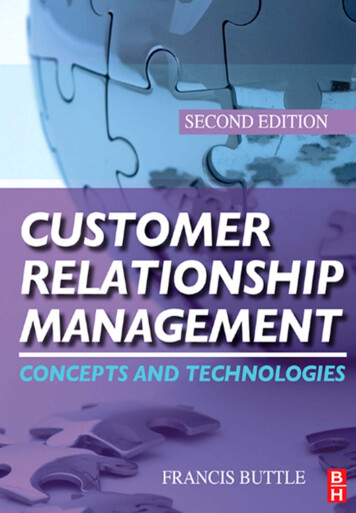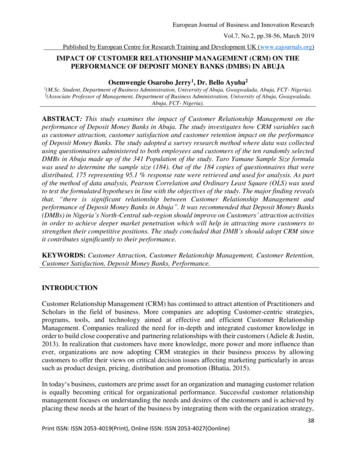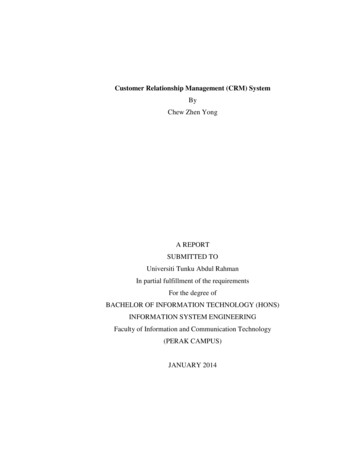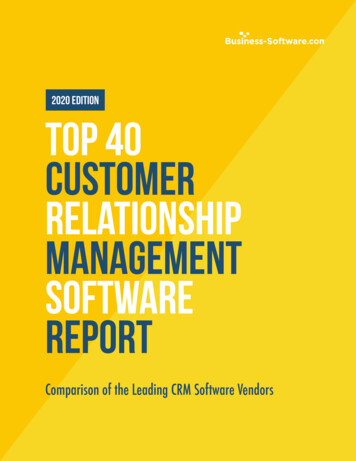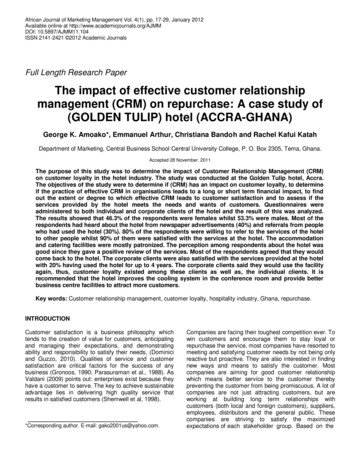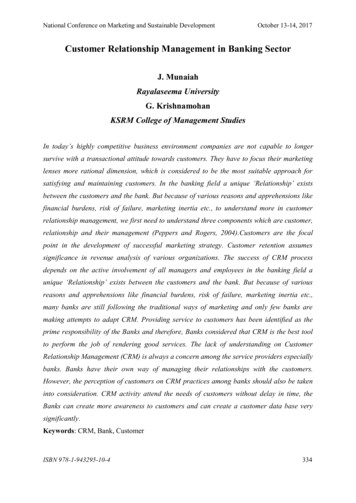
Transcription
National Conference on Marketing and Sustainable DevelopmentOctober 13-14, 2017Customer Relationship Management in Banking SectorJ. MunaiahRayalaseema UniversityG. KrishnamohanKSRM College of Management StudiesIn today’s highly competitive business environment companies are not capable to longersurvive with a transactional attitude towards customers. They have to focus their marketinglenses more rational dimension, which is considered to be the most suitable approach forsatisfying and maintaining customers. In the banking field a unique ‘Relationship’ existsbetween the customers and the bank. But because of various reasons and apprehensions likefinancial burdens, risk of failure, marketing inertia etc., to understand more in customerrelationship management, we first need to understand three components which are customer,relationship and their management (Peppers and Rogers, 2004).Customers are the focalpoint in the development of successful marketing strategy. Customer retention assumessignificance in revenue analysis of various organizations. The success of CRM processdepends on the active involvement of all managers and employees in the banking field aunique ‘Relationship’ exists between the customers and the bank. But because of variousreasons and apprehensions like financial burdens, risk of failure, marketing inertia etc.,many banks are still following the traditional ways of marketing and only few banks aremaking attempts to adapt CRM. Providing service to customers has been identified as theprime responsibility of the Banks and therefore, Banks considered that CRM is the best toolto perform the job of rendering good services. The lack of understanding on CustomerRelationship Management (CRM) is always a concern among the service providers especiallybanks. Banks have their own way of managing their relationships with the customers.However, the perception of customers on CRM practices among banks should also be takeninto consideration. CRM activity attend the needs of customers without delay in time, theBanks can create more awareness to customers and can create a customer data base verysignificantly.Keywords: CRM, Bank, CustomerISBN 978-1-943295-10-4334
National Conference on Marketing and Sustainable DevelopmentOctober 13-14, 20171. IntroductionCustomer relationship management is one of the strategies to manage customer as it focuseson understanding customers as individuals instead of as part of a group. CRM manages therelationships between a firm and its customers. Today, many businesses such as banks,insurance companies, and other service providers realize the importance of CustomerRelationship Management and its potential to help them acquire new customers retainexisting ones and maximize their lifetime value. Banking sector is a customer-orientedservice where the customer is the KEY focus. Research is needed in such sector to understandcustomers‟ need and attitude so as to build a long relationship with them. CustomerCRM is a sound business strategy to identify the bank‟s most profitable customers andprospects, and devotes time and attention to expanding account relationships with thosecustomers through individualized marketing, reprising, discretionary decision making, andcustomized service-all delivered through the various sales channels that the bank uses.2. Customer Relationship ManagementIn literature, many definitions were given to describe CRM. During the last decades there hasbeen strong orientation on customers‟ satisfaction by fulfilling their needs and wants asmeans for the achievement of organization‟s objectives. This underlying motivation oncustomer focus is clear mission to create value for customers, stay profitable and gain desiredperformance. By creating value for customers organizations would gain customers‟ loyalty,which in turn would result in business‟ growth and profits. The main difference among thesedefinitions is technological and relationship aspects of CRM.3. Research ProblemBanking sector has always been the focus of society due to its essential role in the financeworld and the wellbeing of world‟s economy. Particularly in banking sector, the role of CRMis very vital in leading the banks towards high level and volume of profits. So there is a needto study the role of CRM in development and promotion of banking sector through thesidelines of the practices, problems and impact of the CRM on banking sector all the time.4. Objectives of the StudyThe main objectives of the study isISBN 978-1-943295-10-4335
National Conference on Marketing and Sustainable DevelopmentOctober 13-14, 20171. To study and understand the concept of CRM.2. To study the CRM Practices in Banking Sector.3. To study the Benefits of CRM context in Banking Sector.5. Data CollectionThe presents study is completely based on secondary sources of data collection such aselectronic resources, books, journals, magazines, with the objective of successfullycompletion of ongoing study data are collected from published and unpublished sources.Customer Relationship Management: A Brief History 1980s: Database Marketing. Thepromise of database marketing? To speak individually to countless customers. The reality: It'stoo costly, too difficult, and doesn't pay out on the bottom line, except in the case of businessto-business key account marketing. The compromise: A little database marketing goes a longway, which is very good news for everyone except technology vendors. You can do quitewell simply by knowing how recently and frequently customers purchase; how much theyspend; what they purchase; and an iota of demographics. Almost everything else is fluff andgloss.In 1986, ACT! Introduced the business world to contact management software. Essentiallya digital rolodex, ACT! Allowed for the efficient storage and organization of customercontact information. Goldmine and other vendors also released CMS programs throughoutthe 80s.Near the close of the decade, the proliferation of personal computers and the advent ofserver/client architecture paved the way for an explosive growth in software development.1990s: Relationship Marketing. Major phenomenon: Loyalty programs. Major promise:Loyalty! Major result: Companies such as airlines now have an enormous incremental layerof expenses, without much to show for it. It's the familiar promotional conundrum: If yourcompetition promotes, you have to promote equally, which eventuates in everyone makingless money. But if you unilaterally withdraw from such competition, market share collapses.And, alas, no one, at least on the consumer and small business end of things, can tell thedifferences between loyalty, bribery, or inertia. 3. Early 2000's: Customer RelationshipManagement (CRM). Major phenomenon: Great promise. Major reality: Promise unattained.ISBN 978-1-943295-10-4336
National Conference on Marketing and Sustainable DevelopmentOctober 13-14, 20176. Importance of CRM Systems in Modern Retail Banking"Central banks don't have divine wisdom. They try to do the best analysis they can and mustbe prepared to stand or fall by the quality of that analysis.” This quote from Mary Kay Ash,founder of Mary Kay cosmetics shows the key to the wisdom of banks – analysis. Likecentral banks, retail banks today recognize they must identify, attract and retain profitablecustomers. The question is how to do this.Banks, historically, have taken a non-holistic approach to customer management andcustomer service, offering products and services which satisfied the banks rather than thecustomer‟s needs. Retail banks today recognize that this can no longer be the case. They mustbe able to react to the individual customers requirements for flexible, customized services andproducts that can be accessed through multiple channels. In other words, they must becompetitive in a competitive market.Historic entrenchment, however, has made banks reluctant to enter into the banking CRMworld which would allow front line branch personnel the ability to manage the customer witha holistic product package. Knowing the customers‟ needs at the initial point of contactallows for the ability to up-sell as well as cross-sell a full range of financial products andservices.Though, a bank's senior decision makers fully understand the branch process and thenecessity for it, they have somewhat less understanding of their electronic customer base. It isthis gap in knowledge that in many cases causes a reluctance to institute a CRM system.There are concerns about expenses associated with the system, the ease at which the systemcan be accessed by front line personnel and the relinquishing of authority to the front lines.Even more frightening to the entrenched bank establishment is the relinquishing of choice tothe customer themselves.How then, can a CRM system assist these retail establishments in increasing their ROI?CRM success in retail banking depends on measurable ROI over a short period. Expendituresand prospective earning over an established period of time must be defined. With thisinformation the return from a CRM system can be measured.One significant issue for physical retail banking is the shifting peak periods–the need toreallocate idle or untapped branch resources during peak periods will have a positive impacton ROI. An integrated CRM system can help to shift these resources through equal access tocustomer information. The concept of the process driven workflow in a retail bank needs aISBN 978-1-943295-10-4337
National Conference on Marketing and Sustainable DevelopmentOctober 13-14, 2017CRM system which can Capture customer data at the point of entry into the banking system – the branch. Ensurethat all customer information and history are accessible – allowing the branch to foster thecorporate identity of the organization. Provide quality information on each customer interaction that can then be accessed bysenior management in timely reports which allow more refined analysis than previouslyavailable. Enable bank marketing to easily identify customer contacts by market segment and targetcorrespondence to those customers most likely to acquiesce to the product or serviceoffering. Ensure that the customers experience within the system is consistent across all channels.The Banking CRM system also integrates the electronic customer identity into theorganization. No longer is the face-to-face bank contact required to cross-sell or up-sellproducts. New product introductions, based on the current electronic customer profile, can beoffered though the e-marketing channels.The Major Benefits of Analytical CRM to Banks are1. Customer Retention2. Fraud Detection3. Optimizing marketing efforts as per customer life time value4. Credit Risk Analysis5. Segmentation and targeting6. Development of customized new products matching the specific preferences and prioritiesof customers.Collaborative CRM – These involve systems facilitating customers to perform services ontheir own through a variety of communication and interactive channels. It brings peopleprocess and data together and enables channelling of data and information appropriately tobank staff for proactive decision making and enhanced informed customer service andsupport activities. It provides a means of information sharing to all concerned in timelymanner and includes customer as a creator of service. The major benefits of collaborativeCRM to banks are1. Providing efficient customer communication across a variety of channelsISBN 978-1-943295-10-4338
National Conference on Marketing and Sustainable DevelopmentOctober 13-14, 20172. Online services to reduce customer service costs3. Providing access to customer data while interacting with customers.Thus, CRM can be understood as a catalyst enabling transformation of Banking fromtraditional „Transactional banking‟ to „Relationship Banking‟ by use of technology.CRM in Banking: Global ScenarioWorldwide banks have explored and realized the benefits of CRM in a variety of ways.Different banks have implemented the philosophy in their own different way. A fewillustrations will give a glimpse of the global scenario with respect to CRM in Banking.Royal Bank of Canada utilized CRM to develop models of assessment of customerprofitability and life time value. These were then included in determining customer decisionslike – Customized Marketing campaign, establishing service levels, segmentation, targeting,product design and pricing. Customer‟s vulnerability to attrition also is analysed and the mostvaluable are flagged before they defect, in order to take preventive action in a focused andeffective way.Wells Fargo Bank renowned for leadership in service and convenience to varied customersegments focused on customer service through CRM. Application of CRM enabled betterintegration of customer information and service applications to assist representatives ofcustomer sales and services to easily provide a one-stop-shop for any banking service ortransaction. Using CRM, Wells Fargo takes full advantage of available customer informationto offer customer the choice, convenience and price benefits so that they give the Bank, alltheir business.Wachovia Bank uses customer transaction data to support modeling processes that evaluateeach branch‟s current and long term profitability. In Atlanta Bank‟s largest market,significant performance improvements were attained when it used the output of modelingprocess as a basis to decide which of its 96 branches to close and which location to open newones.7. Challenges Faced by Banks in Successful Implementation of CRM1. The difficulty of obtaining a complete view of customers.2. The need to move away from disjointed, standalone, and inconsistent channels to providea cohesive, multichannel offering.ISBN 978-1-943295-10-4339
National Conference on Marketing and Sustainable DevelopmentOctober 13-14, 20173. The burden of disconnected legacy systems and disparate databases that store clientfinancial data.4. The cos
Capture customer data at the point of entry into the banking system – the branch. Ensure that all customer information and history are accessible – allowing the branch to foster the corporate identity of the organization. Provide quality information on each customer interaction that can then be accessed by senior management in timely reports which allow more refined analysis than .
